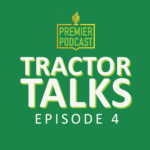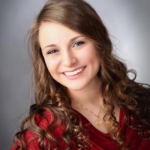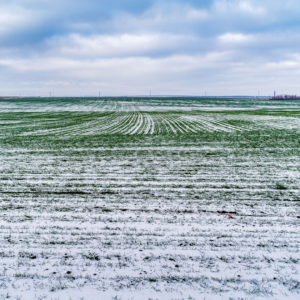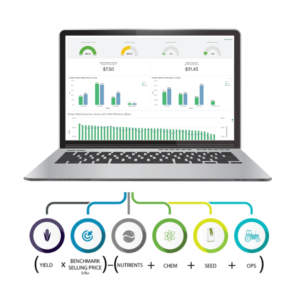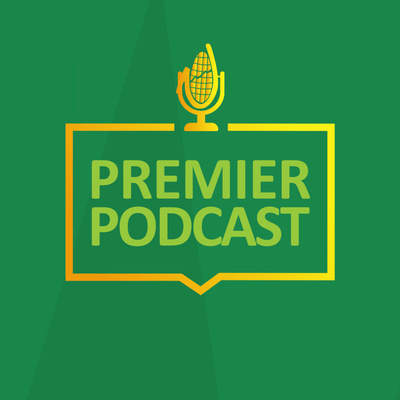
Today on the Premier Podcast we are talking about making fungicide decisions using data with one of our Partners, InSite CDM. We are joined by Clint Sires and Pat Mai. If you are enjoying the show, tweet us using #PremierPodcast.
CLINT SIRES: Yep. So Clint Sires. I’ve been with Ag Partners now for — it’ll actually be 12 years in October. I have been the lead for the InSite CDM program for the past, I’m going to say, six or seven years, something like that. Then, more recently, I’m kind of in charge of all the different data systems that we offer, whether it’s WinField R7 Field Forecasting Tool or Climate FieldView, just kind of in charge of making sure those things are getting done and getting utilized. But then, with InSite CDM, I coordinate the selling and delivering of the program through our sales agronomists and our InSite CDM account managers. Then, I take an active role in putting our agenda together for our customer forum, our big grower meeting at the end of the year, and putting out a newsletter and things like that.
PAT MAI: I’m Pat Mai. I’ve been with the company for two years. I’m an account manager with Ag Partners. In September, it’ll be two years. My role is to take the data out to the farmer and collect it and show him what he’s collected and how useful it is to him.
RENEE HANSEN: Great. Thanks guys. Thanks for coming on the podcast today. We were talking a while back, about two weeks ago, about how a grower had approached you, Pat, in regards to a question on fungicide. So it’s that time of year when growers aren’t even thinking about fungicide and whether or not they should spray it. How do you walk them through that conversation?
PAT MAI: Well, first of all, we kind of start with yield goals. Are they shooting for 180-bushel corn or 210 or 250? What’s realistic at this point? So that kind of starts it off. Usually from there, they talk about their insurance levels. Clint created a nice calculator to show where your APH is, and if you’re at 80%, what your break-even will be. So that’s just a nice visual to prove to them if their break-even is 170 bushels. Well, they think they can do better than that. So, then, we kind of go on from there. Big point we throw around is crop rotation. The data has always shown that corn-on-corn pays to put a fungicide on. So that’s kind of an easy conversation to have. Those are kind of the four or five big points. Row spacing: 20-inch rows or 30-inch or 15-inch. Just from there, we talk it over and go from there.
CLINT SIRES: Yeah, and I guess I would just echo what Pat is saying, what the grower always is trying to do. I mean, if they’re just trying to be efficient and scout for disease and spray when needed, I guess, in my opinion, that’s what you should be doing. You should be out there scouting varieties and seeing what kind of disease you’ve got. But, then, we’ve got the other spectrum of grower, where they’re always trying to push the needle and push the envelope and trying to get the biggest yields possible. We have some growers that they probably only select varieties that respond to a fungicide. They’ve got high scores for not only fungicide but nitrogen, those kinds of things, the higher-managed varieties, I guess you could say. And it seems like the ones that have a hole in them, meaning they’re susceptible either to disease or they don’t emerge well or something like that, those are usually the ones that are super offensive. And if you get the right year, if you hit the right growing season, they produce really well. So, if you’re on that side of the spectrum, it’s easier to just say: ‘Well, you should be applying the fungicide because you’re probably pushing population rates.’ Like Pat said with row spacing, management zones, you’re probably right on that line of keeping everything going and healthy as it is. And fungicide not only eliminates the disease, but there’s that plant health benefit to it.
So that makes that much easier to add to the conversation, then. I’ve always tried to look at the data and prove at what yield environment you should be applying a fungicide, and I’ve always found that a little bit tricky. As we get over a large database — a lot of acres, a lot of geographic area — there’s a lot of, I don’t want to say noise in the data, but it just brings in a lot more variability. So it’s not always a clear-cut thing. But within the program, we’ve identified yield ranges that you want to be in. If you’re within that certain top-level yield range, even in first-year corn, fungicides should probably just be an automatic for you because, again, you’re pushing nitrogen. You’re pushing populations and so forth. But if you’ve got a field that, realistically, you’re happy with 180 bushel or something sub-200-bushel corn, then it’s probably more of: ‘Well, does that variety respond to fungicide? Do I have disease pressure in that field? What are the conditions? Has it been hot and wet? That really favors disease. Or has it been hot and dry? Or cool and dry, where maybe diseases aren’t going to be that big of a deal.’ So, then, it’s not quite as easy of a slam dunk, that you’re going to get your investment back out of that.
RENEE HANSEN: So we’re in a drought year. It was pretty dry up by where your area is. Hopefully, you guys did get some rain last night maybe. So what do you say? They’re shaking their heads. No, that’s not good. What do you say in a drought year? What does your data show? Do you show if it is a wet year versus a dry year? What’s the data show with fungicide in regard to that?
CLINT SIRES: I’ll take this one, Pat. Back in 2012, it was the first time in my career where we hit a major drought, and there were a lot of growers at that time calling us and saying: ‘Hey, what’s the data show?’ And at that time at Ag Partners, we had a growing database, but it’s nowhere near as large as it is now. And through that time, where we had a significant number of acres, we didn’t have a pool, where we could go in and say: ‘Okay, this is an absolute dry year, dry conditions, and how did the fungicide do?’ And it was really cool at that time because, working with our Premier Crop advisor, they said: ‘Well, hey, let’s look at not necessarily the north group data, which is what we had access to, but more of our east region data, which was Illinois and Indiana, and some of that kind of information, where they had just gone through a drought, I think, like three or four years earlier.’ So we did a lot of querying of that database and showed growers at the time that, hey, just because it’s dry, if you think you’re going to have a crop out there, you should be applying the fungicide because, with the plant health benefits and stuff, we saw a really significant response in those areas. But you can also see in that data, too, where, if your crop is burning up, and you’re not going to have a crop or anywhere near what you normally do, it’s probably prudent to save that money and not spend it on a fungicide. So, then, it kind of goes back to what Pat was talking about before, what the grower’s yield expectation is. To answer your question, that’s where we have had success. But, now this year, running queries on the data, we have that 2012 data pool. So not only was it hot and dry for much of our territory that year, but we have a lot of acres to draw on locally from that year. So a lot of what we’re doing with newsletters and the videos and stuff that we’re sending out now is based off of that 2012 information.
RENEE HANSEN: Great. So Clint is basically saying if you want to get that information, you need to be in the InSite CDM program to get it.
CLINT SIRES: That’s correct.
RENEE HANSEN: That’s the benefit of being in the program. Nice pull there, Clint. But, also, you guys are not only dealing with data. You’re also dealing with agronomy, and you’re talking to growers about agronomy. So, Pat, can you share some of the conversations that you’ve had and how you’ve had to be that agronomist for them, as well? And you talked about it a little bit, but, I mean, you definitely go out to the field and look at it, as well.
PAT MAI: Yeah, I guess going out and looking at it right now, there are pockets that are starting to go the other way. So you kind of make a judgment call. Is 3% of your field, 5% of your field non-sandy spots? A lot of guys just kind of focus on those spots, and they forget about the rest of it that’s still doing okay. So do you make a judgment call on just 5-10% of your acres, or do you try to save what you got? Disease pressure, there isn’t a whole lot right now. So, typically, you want to wait a little longer. But through pollination, I guess, you want to protect that plant and extend that process as long as possible to get good grain fill. So, agronomy-wise, I guess that’s kind of where you go too.
RENEE HANSEN: Okay, great. Another thing would be planning and working with the grower from the plan from the beginning of the year. And can you talk about how you include that plan, that fungicide plan, at the beginning of the year and how it’s easier to have that conversation when it comes time to spray?
PAT MAI: Yeah, I guess, off of the past years of the data, it’s kind of showing that fungicides are paying. So a lot of guys are just prepaying for a lot of the fungicide and are planning on doing it no matter what. And with the prices the way they are, most guys still are going to do it. Some might hold their product back because they think it’s going to be more expensive next year. So they might keep it for next year. But all in all, off of the years and years of data we’ve collected, it shows for a fungicide. So, I mean, it’s pretty easy to put it in their plan now and just plan for it.
RENEE HANSEN: And you alluded to this too, Pat, that you talked about their costs. How do you guys within InSite CDM help a grower, tracking their economics and their profitability within the field? Do you talk to them about yield efficiency?
PAT MAI: Yes, we do. With the cost tracking, there again, with Clint’s calculator, that’s pretty easy to do. With the cost tracking, just kind of show what your yield response is, if you need four or five bushels to make that fungicide treatment pay. Overall, if you show how many years of the last 5-10 years, the average is pretty high. With what the cost is nowadays, even as high as it is, it still shows that it’s paying.
RENEE HANSEN: Do you have anything to add there, Clint, in regards to planning and tracking with economics?
CLINT SIRES: Yeah, I mean, the things that we’re rolling out through InSite CDM, with the help of Premier Crop, with the cost tracking, and then now with the cost forecasting, I think that definitely gets growers thinking about it in terms of a business and income per acre, what the potential is. That’s one thing I really like about that calculator. It’s because it gets you thinking about what the potential income is based on the prices, of where they’re at and where they can go. Because, in my mind, it’s really easy for a grower to say: ‘Ah, I’m going to collect insurance on that anyway. I don’t want to just save the insurance company money.’ I get that argument, up to a point. I’ve seen that before too, where you know you’re going to get an insurance payment, and you do. But, then, the price of the crop goes up, and so you’ve still got those bushels sitting there. And the more you’ve got, obviously, the better off you’re going to be at that point. Now, I understand, too, you can choose to just sell it when you get your insurance payment. Maybe some guys do that too, but there’s definitely a lot to think about. I like having the new tools because it helps growers look at that and think about it, with a visual in front of them, rather than just me talking about: ‘Well, the price could do this, and the price could do that.’ They actually get to see it, either in a chart form or a table or something like that. I just think that helps make a lot more sense. A lot of our growers have been doing something with costs, one way or the other. The adoption of cost tracking through InSite CDM hasn’t been like 100% overnight or anything like that, but we have made some really good gains with the growers that are experiencing that over the last year-and-a-half or so. And what was more important to me is the number of growers that continued on with the cost tracking into 2021 because it’s not something today that we just give away and just do for free.
Ag Partners has a lot more time and effort invested in that. We believe the grower’s getting more value out of it. So we charge for that service. That comes with some benefits, meaning, I think, the grower looks at that and says: ‘Okay, I’m paying for this. Now, I have to give you the best data possible to feed the, for lack of a better word, model, when you’re doing the forecasting part of it.’ Garbage in, garbage out, we always say. So, if they’re doing their part and getting accurate information, they have a vested interest in making sure that, when we show them their cost per bushel — whether it’s at the farm level, the field level or within the management zone — if it’s a number they’re going to believe, they’ve got to give us the right, accurate information going into it upfront. So that’s definitely the positive with charging. The drawback with charging, especially eight months ago, when we were talking about $3 whatever corn and $8 beans, another dollar an acre — whatever you charge for it — is really hard to get a grower to believe when they’re looking at losing money at the end of the year. So it’s just another dollar of cost. So it’s really on us to show them how they benefit and profit from that extra information. And that’s where we’re lucky to have account managers like Pat, to be able to dig into that and actually show them that, because otherwise you’re just recording data and not really doing anything with it. I’ve seen the benefit of where guys get to the point where nobody’s really showing them anything or talking about anything until Pat comes in and lays it all out and says: ‘Why wouldn’t you do this? Or do more of this? Or less of that?’ Or whatever. Then, it’s like a rebirth in the program. They’re bought in again. The program is only as good as somebody that’s explaining it to them, and we’re definitely seeing a lot of that with the direction we’re going. So we’re very happy about that.
RENEE HANSEN: Yeah, when you guys are providing a value service to the grower, where they are continuously learning and continuously improving, it’s something that is so valuable to their operation because it’s helping them win in the end, no matter what. And you guys continue to do that. And, also, we talked about how you have the data for fungicides and whether they should apply or they shouldn’t, but you also have that data for whether they’re picking their hybrid, their variety, when the best time is to put anhydrous on, your nitrogen rates. You guys have all of this valuable information that a grower can get once they’re in your system, and it’s something really valuable that you guys provide. I know you guys are passionate about what you do. So can you just explain to me what excites you the most about offering the InSite CDM program to your growers?
CLINT SIRES: Well, I’ll go first. Renee, you touched on it there a little bit, having the data to make that fungicide recommendation. But it’s so much more than that. I mean, when you get all the way into what I would call the depths of the program, where you’re utilizing the management zones and nitrogen rack and stuff like that, that we do, it really is a complete system. So, when you go back to the decision of whether or not to use fungicide, well, it really depends on what you’re doing as a system. Did you select that variety that’s going to respond to it? Are you pushing that population? Have you fed that variety the way it needs to be fed in the areas of the field that will respond to that? It’s really a whole system approach, and not all of our growers are to that level. I mean, some, depending on where they’re at when they get into the program, management zones might be a big deal. They don’t have a lot of yield data and haven’t variable-rate planted or anything like that before. That’s certainly somewhere where you start, and then variable-rate planting is kind of like the next piece of that. You see a lot of excitement with that, but it’s really not until you tie the food to the seed and are putting the seed in the right spot and doing all those things.
To answer your question, what excites me is seeing those growers that think they’ve kind of got things figured out until they get in the room with Pat and start having that conversation and find out: ‘Whoa, there’s a lot more to this than I even thought you could do.’ I’ve been through some of those meetings before, in the past, where you’ve got a grower that’s maybe been in InSite CDM for awhile, and nobody’s really showing them anything. And it’s kind of like: ‘Well, what have you done for me lately?’ And we sit down and actually go through their zones and bring up each individual field and talk through why it was set up the way it was. Pretty soon, the grower’s getting up out of his chair — because we’re projecting his management zone on a screen, on a map on the wall or whatever, a larger screen — and he’s getting up out of his chair, going: ‘No.’ Pointing at this: ‘This area shouldn’t be this way because this always happens there. You need to change it to this, and we need to do this over here and change that.’ And it’s usually when me and the advisor — me and the salesperson or whatever — we just kind of have a look that: ‘Okay, this guy’s getting it now. He’s bought in.’ These are becoming his zones, not just something where we said it had to go there for this reason or whatever. I think that’s where I get some of my most enjoyment from the program.
PAT MAI: Yeah, I agree with Clint. That’s always pretty exciting, to see the guys up and even, not really arguing, but kind of arguing with you, saying: ‘Well, it should be like this.’ Then, you can pull up data, saying: ‘Well, your fields did this and this and this.’ And they’ll like: ‘Oh yeah, you’re right. It was like this.’ Then, you really prove it to them. A lot of what I hear back from guys is that you get to hear a lot of real-world results instead of like all the coffee shop talk you hear that kind of puts everybody in perspective. I don’t know. Guys like to see that instead of just everything they hear in town. That’s where I get a lot of common zones. Other things: I like to go out to the farm with real-world data. I can prove to them and show to them all your neighbors that are in the program and, in a 5-20 mile radius, how stuff yielded and with different soil types and show them the yields. And this is why we should be doing it this way, instead of just listening to the other three or four people in his ear. It’s just nice to have real-world data that’s not lying to you. So that’s the biggest thing. You’re not wrong. You can’t argue with the data. We know it’s good data, so here it is.
RENEE HANSEN: That’s excellent. So how can a grower in your area get a hold of you guys? How can they get a hold of InSite CDM?
CLINT SIRES: Well, they would just talk to either their Ag Partners sales agronomist or go to our Ag Partners website, where we’ve got a precision ag area. You can click on that and learn more about InSite CDM, and then there are links to click on to get a hold of somebody for more information.
RENEE HANSEN: Great. Well, thanks for coming on today, guys. So glad to have you, and we’ll catch you next time.
CLINT SIRES: Sounds great. Thanks for having us.
PAT MAI: Thanks, Renee.
RENEE HANSEN: Thanks for listening to the Premier Podcast, where everything agronomic is economic. Please subscribe, rate and review this podcast so we can continue to provide the best precision ag and analytic results for you. If you want to learn more about InSite CDM, check out our show notes. And to learn more about Premier Crop, visit our blog at premiercrop.com.

